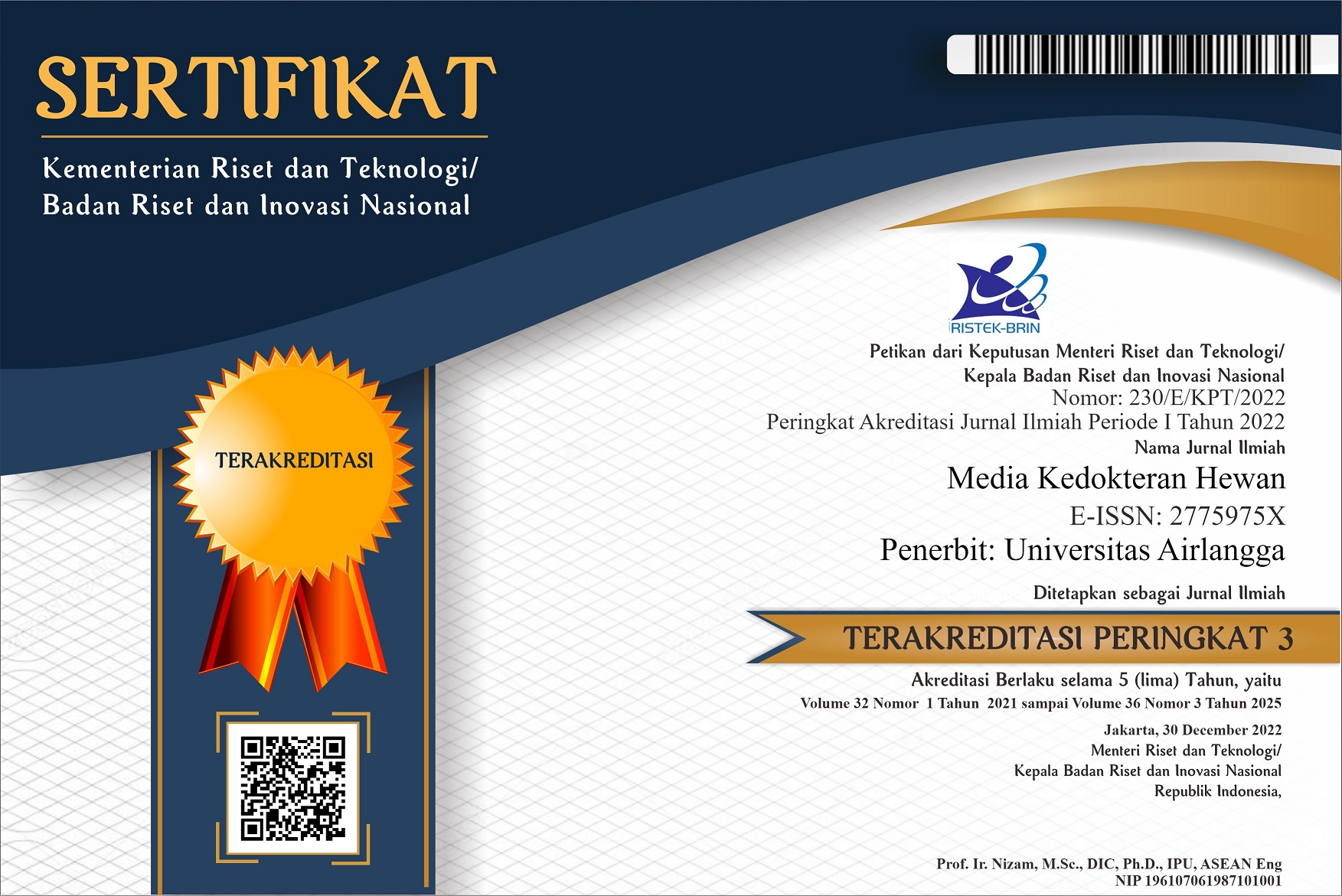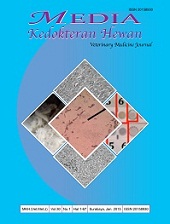Case Report: Ehrlichia ewingii Infection in a Shih Tzu Mix Dog
Downloads
Ehrlichiosis is a dog disease caused by Ehrlichia, a gram-negative intracellular bacterium, and transmitted by ticks of the genus Rhipicephalus sanguineus. This case report aims to identify the infectious agent and describe the treatment for a case of ehrlichiosis. The examination results showed signs of ehrlichiosis in a male shih tzu mix dog aged three months. The dog had been suffering from itching, weakness, decreased appetite, and tick infestations over the entire body for the past month. The physical examination showed that the dog was limping and had pale oral mucosa. Meanwhile, the routine hematological examination showed signs of neutrophilia, hypochromic microcytic anemia, and thrombocytopenia. In addition, the blood smear examination showed intracytoplasmic bodies in the neutrophils of the dog. Blood tests using the test kit showed a positive result for ehrlichiosis. The dog was diagnosed with ehrlichiosis with a good prognosis. The treatment included doxycycline at a dose of 10 mg/kg BW q24h PO for 28 days, Livron B.plex at a dose of 1 tablet per day PO for 14 days, Fufang Ejiao Jiang at a dose of 1 ml per day PO for 14 days, and Bravecto Spot-on. The condition of the dog improved after seven days of treatment. However, the routine hematological examination on day seven still showed signs of anemia and thrombocytopenia, necessitating continued supportive drugs.
Allison RW dan Little SE. 2013. Diagnosis of rickettsial diseases in dogs and cats. Veterinary clinical pathology. 42(2): 127-144.
Arsyitahlia N, Suartha IN, Soma IG. 2021. Case Report: Anaplasmosis in a Kintamani Peranakan Dog. Indonesia Medicus Veterinus. 10(2): 304-315.
Aryanti N dan Juli S. 2016. Correlation between Immature Granulocytes and Delta He as a Marker of Inflammation in Patients with Lekocytosis. Jurnal Ilmiah Kedokteran Wijaya Kusuma. 5(2): 1-5.
Barman D, Baishya BC, Sarma D, Phukan A, Dutta TC. 2014. A case report of canine ehrlichia infection in a labrador dog and its therapeutic management. Bangl j Vet Med. 12(2): 237 – 239.
Cocayne CG, Cohn LA. 2012. Ehrlichia ewingii infection (canine granulocytrotopic ehrlichiosis). Infectious diseases of the dog and cat. Fourth edition. Elsevier Saunders. St. Louis, Missouri. 241-244.
Cohn LA, Breitschwerdt EB. 2012. Spolight on Ehrlichia ewingii. IDEXX Laboratories, Inc. Disponible en línea en: https://identify.us.com/idmybug/ticks/tick-docs/spotlight-on- ehrlichia.pdf (Acces 11.18.2023).
Dubie T, Mohammed Y, Terefe G, Muktar Y, Tesfaye J. 2014. An insight review on canine ehrlichiosis with emphasis on its epidemiology and pathogenesity importance. Global Journal of Veterinary Medicine and Research. 2(4): 59-67.
Erawan IGMK, Sumardika IW, Pemayun IGAGP, Ardana IBK. 2017. Case report: Ehrlichiosis in a Balinese kintamani dog. Indonesia Medicus Veterinus. 6(1): 68-74.
Fourie JJ, Crafford D, Erasmus HL, Horak I, Botha OJ. 2015. The efficacy of a generic doxycycline tablet in the treatment of canine monocytic ehrlichiosis. Journal of the South African Veterinary Association. 86(1): 1-10.
Gieg J, Rikihisa Y, Wellman M. 2009. Diagnosis of Ehrlichia ewingii infection by PCR in a puppy from Ohio. Veterinary Clinical Pathology. 38(3): 406-410.
Goldman EE, Breitschwerdt BE, Grindem CB, Hegarty BC, Walls JJ, Dumler JS. 1998. Granulocytic ehrlichiosis in dogs from Noth Carolina and Virginia. Journal of Veterinary Internal Medicine. 12(2):61-70.
Harrus S, Waner T. 2011. Diagnosis of Canine Monocytotropic Ehrlichiosis (Ehrlichia Canis): An Overview. Vet. J. 187: 292–296.
Huhn C, Winter C, WT, Wüppenhorst N, StraÅ¡ek SK, Skuballa J, Pfäffle M, Petney T, Silaghi C, Dyachenko V, Pantchev N, Straubinger RK, Schaarschmidt-Kiener D, Ganter M, Aardema
Inokuma H, Raoult D, Brouqui P. 2000. Detection of Ehrlichia platys DNA in brown dog thicks (Rhipicephalus sanguineus) in Okinawa Islands, Japan. Journal of Clinical Microbiology. 38(11): 4219-4221.
Jayanegara AR. 2020. Kasus Canine Monocytic Ehrlichiosis (CME) pada Anjing. Bogor: IPB University.
Koh FX, Panchadcharam C, Tay ST. 2016. Vector-Borne Diseases in Stray Dogs in Peninsular Malaysia and Molecular Detection of Anaplasma and Ehrlichia spp. from Rhipicephalus sanguineus (Acari: Ixodidae) Ticks. J of Med Entomology. 53: 183- 187.
Komnenou AA, Mylonakis ME, Kouti V, Tendoma L, Leontides L, Skountzou E, Dessiris A, Koutinas AF, Ofri R. 2007. Ocular Manifestations of Natural Canine Monocytic Ehrlichiosis (Ehrlichia Canis): A Retrospective Study of 90 Cases. Vet. Ophthalmol. 10: 137–142.
Li X, Chen L, Hou M, Jai, Qi S. 2013. Curative efect of Fufang Ejiao Jiang on cancerrelated anemia. Modern Chinese Clinical Medicine. 20(6): 27–30.
Little SE. 2010. Ehrlichiosis and anaplasmosis in dogs and cats. Veterinary Clinics: Small Animal Practice. 40(6): 1121-1140.
McDade JE. 1989. Ehrlichiosis-A disease of Animal and Humans. Thse Journal of Infection Disease. 161: 609-617.
ML, von Loewenich FD. Analysis of the population structure of Anaplasma phagocytophilum using multilocus sequence typing. PLoS One. 3(4): 9-16.
Murphy GL, Ewing SA, Whitworth LC, Fox JC, Kocan AA. 1998. A molecular and serologic survey of Ehrlichia canis, E. chaffeensis, and E. ewingii in dogs and ticks from Oklahoma. Veterinary parasitology. 79(4): 325-339.
Mylonakis ME, Theodorou KN. 2017. Canine monocytic ehrlichiosis: an update on diagnosis and treatment. Acta Veterinaria Beogar. 67(3): 299- 317.
Nesti DR, Ahmad B, Febri A, Ida T. 2018. Detection of Zoonotic Ehrlichiosis in Dog Patients at Jogja Veterinary Clinic. Jurnal Nasional Teknologi Terapan. 2(2): 191-197.
Pradnyandika IPKA, Soma IG, Suartha IN. Case Report: Recurrent Ehrlichia canis Infection in Monocytes of an Akita Peranakan Dog in Denpasar, Bali. Indonesia Medicus Veterinus. 11(4): 519-529.
Pratiwi DA, Widyastuti SK, Suartha IN. 2022. Case Report: Fatal Recurrent Anaplasmosis and Ehrlichiosis Infection in a Pomeranian Dog. Indonesia Medicus Veteriner. 11(4): 555-565.
Procajlo A, Skupien EM, Blandowski M, Lew S. 2011. Monocytic Ehrlichiosis in dogs. Polish Journal of Veterinary Sciences. 14(3): 515-520.
Putra WG, Widyastuti SK, Batan IW. 2019. Case Report: Anaplasmosis and Ehrlichiosis in a Village Dog in Denpasar, Bali. Indonesia Medicus Veterinus. 8(4): 502-512.
Sahoo KK, Gupta DK, Kabita R, Amita T, Arpana R, Shashi P, Sonali N, Govind PC, Ayushi S, Shruti B, Mitali S. 2020. Canine Ehrlichiosis: A Review. The Pharma Innovation Journal. 11(2): 474-480.
Skotarczak B. 2003. Canine Ehrlichiosis. Ann Agric Environ Med. 10:137–141.
Starkey LA, Barrett AW, Beall MJ, Chandrashekar R, Thatcher B, Tyrrel P, Little SE. 2015. Persistent Ehrlichia ewingii infection in dogs aftere natural tick infestation. J Vet Intern Med. 29(2):552-555.
Sulistiyani I. 2016. Benefits of Cytology for Skin Disease Screening in Dogs and Cats. Tangerang.
Viviano KR. 2020. Antimicrobial therapy in dogs and cats, dalam Clinical Small Animal Internal Medicine. 1041-1048.
Wang Y, Xu R. 2011. Research progress on the application of Fufang Ejiao Jiang. Chinese Journal of Clinical Rational Drug Use. 4(12):151–153.
Copyright (c) 2024 Nonitema Nazara, Putu Devi Jayanti, I Nyoman Suartha

This work is licensed under a Creative Commons Attribution-ShareAlike 4.0 International License.

Veterinary Medicine Journal by Unair is licensed under a Creative Commons Attribution-ShareAlike 4.0 International License.
1. The Journal allows the author to hold the copyright of the article without restrictions.
2. The Journal allows the author(s) to retain publishing rights without restrictions
3. The legal formal aspect of journal publication accessibility refers to Creative Commons Attribution Share-Alike (CC BY-SA).





11.jpg)







11.png)













